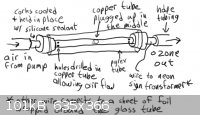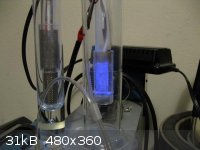Melgar
Anti-Spam Agent
    
Posts: 2004
Registered: 23-2-2010
Location: Connecticut
Member Is Offline
Mood: Estrified
|
|
Simplified ozone generator
I designed this ozone generator to be easy to build, since you just need a length of glass tubing (you can use old fluorescent tubes), two corks with
center-drilled holes, a short length of copper tube, silicone sealant, and of course the requisite air pump and neon sign transformer. It just
simplifies construction a little bit since the inlet tube, outlet tube, and inner electrode are combined into one piece. It also allows for a decent
air flow to maximize ozone generation.
Instead of corks, you can just wrap the copper tube with massive amounts of electrical tape so it forms plugs at the ends.

[Edited on 2/18/11 by Melgar]
[Edited on 2/18/11 by Melgar]
|
|
|
hissingnoise
International Hazard
    
Posts: 3940
Registered: 26-12-2002
Member Is Offline
Mood: Pulverulescent!
|
|
Fluorescent tubes won't be robust enough for your purposes.
And an aluminium rod would make a better electrode - ozone attacks copper and rubber.
The air supplied should be dry; moist air produces NO<sub>2</sub> as well as ozone.
|
|
|
Melgar
Anti-Spam Agent
    
Posts: 2004
Registered: 23-2-2010
Location: Connecticut
Member Is Offline
Mood: Estrified
|
|
Yeah, I suppose fluorescent tubes would probably be too thin. It'd be simple enough to substitute an aluminum tube for the copper one, although
aluminum tubes may be a bit harder to find. For the glass, maybe a broken graduated cylinder or the neck of a cracked flask could be used. Or just
the right size tube if you can get it. There are also some huge test tubes out there that're like an inch in diameter, that you could cut the bottom
off of and use.
|
|
|
hissingnoise
International Hazard
    
Posts: 3940
Registered: 26-12-2002
Member Is Offline
Mood: Pulverulescent!
|
|
A thick Al welding rod would make a good electrode and a scrap freezer is a source of easily manipulated Al tubing . . .
Teflon is inert to ozone and other plastics may be too, but you'd need to google that!
Commercial ozone generators use SS (416?) possibly.
|
|
|
WSM
Harmless

Posts: 5
Registered: 25-2-2010
Member Is Offline
Mood: No Mood
|
|
The most common polymer (plastic) used for ozone handling is less expensive than teflon and is called Kynar (or PVDF). It costs about 20% as much as
teflon and will handle ozone without breaking down.
A compatible rubber material is Viton. It is expensive but will handle a lot of abuse.
WSM
[Edited on 3/2/2011 by WSM]
|
|
|
Melgar
Anti-Spam Agent
    
Posts: 2004
Registered: 23-2-2010
Location: Connecticut
Member Is Offline
Mood: Estrified
|
|
I came up with a new ozone generator concept that uses a beer bottle, a cork, and a metal tube as its components. This is a lot simpler than the
first one, but still uses the inlet tube as one of the electrodes. This one is nicer because you don't have to do anything to the tube besides cut it
the right length, and the glass insulator is just a beer bottle. I should build one of these things and make sure it stands up to the electric
arcing. I think it will though; beer bottle glass is pretty thick.

|
|
|
hissingnoise
International Hazard
    
Posts: 3940
Registered: 26-12-2002
Member Is Offline
Mood: Pulverulescent!
|
|
If you have glassblowing skills you might try to strengthen the ends of fluorescent tubes so that they could take strain stoppers would exert.
Propane is good enough for soda-lime . . .
Failing that, find a friend who can work glass!
|
|
|
condennnsa
Hazard to Others
  
Posts: 217
Registered: 20-4-2010
Location: Romania
Member Is Offline
Mood: No Mood
|
|
hissingnoise, why would only moist air make also NOx? I would've thought that any kind of air, subjected to an electric arc would make nitrogen
oxides...
By the way, here's a cool implementation of the Birkeland-Eyde process a guy made for nitric acid:
http://www.youtube.com/watch?v=Y7M_Ro1prKo&feature=relat...
http://jennwork.homelinux.net/node/3
He claims to make 0.65 mol HNO3/day. but at a wattage of 450 W, it doesn't come out cheap, but the idea of making nitric acid out of thin air is
exciting nevertheless.
|
|
|
hissingnoise
International Hazard
    
Posts: 3940
Registered: 26-12-2002
Member Is Offline
Mood: Pulverulescent!
|
|
| Quote: | | hissingnoise, why would only moist air make also NOx? I would've thought that any kind of air, subjected to an electric arc would make nitrogen
oxides... |
In the discharge-gap of an ozone generator micro-discharge appears as a purplish glow - the bonds in O<sub>2</sub> are broken but not the
triple bonds of N<sub>2</sub>.
Moisture provides a conductive path for the discharges so that they then have arcing characteristics and are much hotter.
Discharges in the BE apparatus are very energetic and the atomic nitrogen produced then reacts and NO<sub>2</sub> is produced.
|
|
|
roamingnome
Hazard to Others
  
Posts: 363
Registered: 9-9-2006
Member Is Offline
Mood: No Mood
|
|
In any design, it comes down to the dielectric material used. It will probably fail first producing a direct short.
These simple pyrex test tubes as dielectric will probably fail mid experiment if left running continuously. I hope pulsing them on/off will preserve
them.

The oxygen tube enters the bottom of the test tube passing up threw the corona
@ condennnsa
making Nitric acid out of think air is interesting. Breaking the triple bond will take its energy.
[Edited on 4-3-2011 by roamingnome]
|
|
|
hissingnoise
International Hazard
    
Posts: 3940
Registered: 26-12-2002
Member Is Offline
Mood: Pulverulescent!
|
|
My archaic BE generator consisted of an enclosed Jacob's Ladder driven by two NSTs in parallel.
Its output was bubbled into water and after several hours running I got very dilute acid.
To reach 68% the thing would have to run for a friggin' year!
The problem is that the concentration of NO<sub>2</sub> in the output is so small that to capture all of it large, complex absorption
towers would be needed.
|
|
|
DougTheMapper
Hazard to Others
  
Posts: 145
Registered: 20-7-2008
Location: Michigan, USA
Member Is Offline
Mood: Energetic
|
|
Hey, what about a condenser?
Put a saturated NaCl solution in the jacket as one electrode and run a wire through the condensation tube as the other. I bet a bit of aluminum
picture-hanging wire through a graham condenser would work wonders. Plus it'll have the ground joint for hooking it up to whatever you need.
Or perhaps a leibig packed with coarse stainless steel wool?
@roamingnome: Is that an Evertron supply I see in the background? I have the 11kV model and it looks exactly the same.
[Edited on 4-3-2011 by DougTheMapper]
Victor Grignard is a methylated spirit.
|
|
|
hissingnoise
International Hazard
    
Posts: 3940
Registered: 26-12-2002
Member Is Offline
Mood: Pulverulescent!
|
|
| Quote: | | Or perhaps a leibig packed with coarse stainless steel wool. |
I suggested something similar in another ozone thread that I cannot now find!
|
|
|
hissingnoise
International Hazard
    
Posts: 3940
Registered: 26-12-2002
Member Is Offline
Mood: Pulverulescent!
|
|
A copper tube pushed through the vapour-path so that it fits snugly.
Any metal will do as it won't be in contact with the ozone produced.
Alufoil wrapped around the outside as the outer electrode.
All that's required then is an air/oxygen supply to the coolant connectors and several kilovolts to the electrodes . . .
|
|
|
Texium
|
Thread Moved
19-11-2023 at 16:27 |